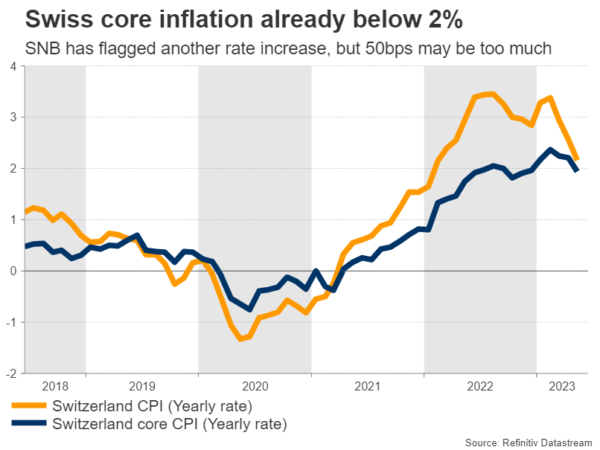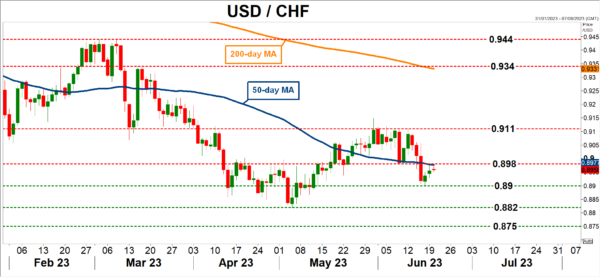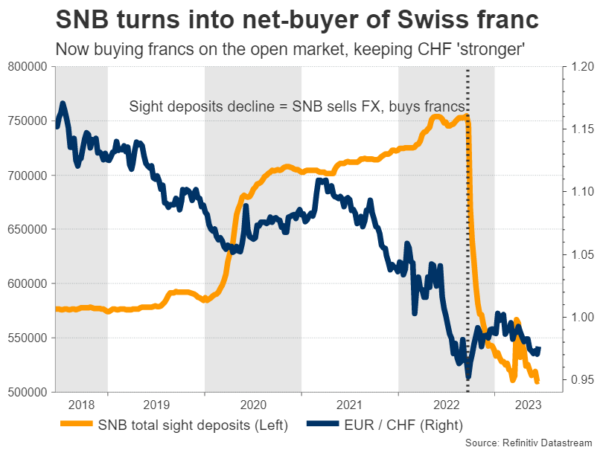The Swiss National Bank (SNB) is widely expected to raise interest rates at 07:30 GMT Thursday, although markets are divided about the size of the move. With inflation grinding lower, the risks seem tilted towards a smaller rate increase that could briefly hurt the Swiss franc, although its overall path will also depend on global risk appetite and FX interventions.
Inflation cools
Switzerland’s economy has been flashing some encouraging signals lately. Economic growth was surprisingly strong in the first quarter of the year, the unemployment rate is near its lowest levels in two decades, and inflation has been falling steadily to reach just 2.2% in May.
The SNB aims to keep inflation positive but below 2%, so it would seem the mission has almost been accomplished. Nonetheless, the latest comments from SNB officials suggest otherwise. Speaking last week, Chairman Thomas Jordan stressed that more rate increases might be required to tackle ‘stubborn’ inflation.
One concern is that inflation could heat up again later this year, as rent prices play catch-up with previous increases in house prices. Another risk is that the longer inflation remains above 2%, the more likely that the inflationary mindset becomes entrenched in consumer and business decisions.
By raising rates further, the SNB can address these threats and equip itself with more ‘ammunition’ to fight the next downturn, as it would have more scope to cut rates and help the economy if it runs into trouble.
Single or double move?
The problem is that raising rates too much can also inflict damage on economic growth, making it a double-edged sword. There are already signs that economic momentum has started to slow as Switzerland’s manufacturing sector is in contraction, and the Credit Suisse episode certainly did not help.
Hence, markets are split on the size of the upcoming rate hike, pricing in a 60% probability for a 50bps rate increase and a 40% chance for a smaller 25bps move. Since the SNB gathers only four times per year, there’s a sense it might ‘frontload’ the rate increases and deliver a larger move.
It’s a close call, but considering the progress on inflation lately, it seems more prudent from a risk-management perspective for the SNB to go for the smaller hike of 25bps, especially following a similar downshift from the European Central Bank last week.
Such a decision could spell bad news for the Swiss franc, at least initially. Turning to the dollar/franc chart, a potential move higher might encounter immediate resistance near 0.8980, which is where the 50-day moving average has converged. A break higher would open the door towards the 0.9110 region.
On the flipside, a 50bps rate hike could trigger the opposite response, sending dollar/franc lower for another test of the 0.8900 zone. If violated, the spotlight would turn to the May low of 0.8820.
The big picture
Looking beyond this rate decision, the broader outlook for the Swiss franc seems rather bright. Even though the SNB has not raised rates as much as other central banks, at least the franc is not haunted by negative rates anymore.
Even more importantly, the SNB has flipped from a net-seller of the franc to a net-buyer. The latest data on sight deposits suggest the SNB still intervenes in the FX market, but it is now actively buying francs and selling foreign currencies. The goal is to keep the currency ‘strong’ and in the process, keep imported inflation under control.
Finally, there’s global risk sentiment to consider, as the franc is a safe haven instrument. If the recent euphoria in riskier assets calms down and concerns about a global economic slowdown resurface later this year, that could be another beneficial force for the defensive currency.


















